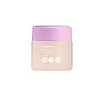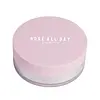Luxcrime Perfecting Hydralight Skin Tint SPF 35 Versus Rose All Day The Realest Lightweight Loose Powder
What's inside
What's inside
 Key Ingredients
Key Ingredients

 Benefits
Benefits

 Concerns
Concerns

 Ingredients Side-by-side
Ingredients Side-by-side

Water
Skin ConditioningCyclopentasiloxane
EmollientTitanium Dioxide
Cosmetic ColorantGlycerin
HumectantPhenyl Trimethicone
Skin ConditioningIsododecane
EmollientDimethicone
EmollientEthylhexyl Methoxycinnamate
UV AbsorberEthylhexyl Salicylate
UV AbsorberCetyl PEG/PPG-10/1 Dimethicone
EmulsifyingCaprylyl Methicone
Skin ConditioningPentylene Glycol
Skin ConditioningHydrogenated Polyisobutene
EmollientZinc Oxide
Cosmetic ColorantSorbitan Sesquioleate
EmulsifyingTrimethylsiloxysilicate
EmollientDimethicone/Vinyl Dimethicone Crosspolymer
Skin ConditioningMagnesium Sulfate
Phenoxyethanol
PreservativeDisteardimonium Hectorite
StabilisingTriethoxycaprylylsilane
Aluminum Hydroxide
EmollientStearic Acid
CleansingEthylhexylglycerin
Skin ConditioningDisodium EDTA
BHT
AntioxidantPhyllanthus Emblica Fruit Extract
HumectantCentella Asiatica Leaf Water
Skin ConditioningPropylene Glycol
HumectantButylene Glycol
HumectantCamellia Sinensis Leaf Extract
Antimicrobial1,2-Hexanediol
Skin ConditioningPyrus Malus Fruit Extract
Skin ConditioningMica
Cosmetic ColorantCI 77492
Cosmetic ColorantCI 77491
Cosmetic ColorantCI 77499
Cosmetic ColorantWater, Cyclopentasiloxane, Titanium Dioxide, Glycerin, Phenyl Trimethicone, Isododecane, Dimethicone, Ethylhexyl Methoxycinnamate, Ethylhexyl Salicylate, Cetyl PEG/PPG-10/1 Dimethicone, Caprylyl Methicone, Pentylene Glycol, Hydrogenated Polyisobutene, Zinc Oxide, Sorbitan Sesquioleate, Trimethylsiloxysilicate, Dimethicone/Vinyl Dimethicone Crosspolymer, Magnesium Sulfate, Phenoxyethanol, Disteardimonium Hectorite, Triethoxycaprylylsilane, Aluminum Hydroxide, Stearic Acid, Ethylhexylglycerin, Disodium EDTA, BHT, Phyllanthus Emblica Fruit Extract, Centella Asiatica Leaf Water, Propylene Glycol, Butylene Glycol, Camellia Sinensis Leaf Extract, 1,2-Hexanediol, Pyrus Malus Fruit Extract, Mica, CI 77492, CI 77491, CI 77499
Talc
AbrasiveMica
Cosmetic ColorantAluminum Starch Octenylsuccinate
AbsorbentNylon-12
Silica
AbrasiveCaprylyl Methicone
Skin ConditioningSynthetic Fluorphlogopite
Dimethicone/Vinyl Dimethicone Crosspolymer
Skin ConditioningBoron Nitride
AbsorbentDimethicone
EmollientMethyl Methacrylate Crosspolymer
Hydrogen Dimethicone
Glycerin
HumectantLycopodium Clavatum Extract
Skin ConditioningPhenoxyethanol
PreservativeIsopropyl Titanium Triisostearate
EmollientImperata Cylindrica Root Extract
Skin ConditioningTocopheryl Acetate
AntioxidantTriethoxycaprylylsilane
Aluminum Hydroxide
EmollientPentylene Glycol
Skin ConditioningRosa Damascena Flower Oil
MaskingRosa Damascena Flower Water
MaskingCI 77891
Cosmetic ColorantCI 77491
Cosmetic ColorantCI 77492
Cosmetic ColorantCI 77499
Cosmetic ColorantTalc, Mica, Aluminum Starch Octenylsuccinate, Nylon-12, Silica, Caprylyl Methicone, Synthetic Fluorphlogopite, Dimethicone/Vinyl Dimethicone Crosspolymer, Boron Nitride, Dimethicone, Methyl Methacrylate Crosspolymer, Hydrogen Dimethicone, Glycerin, Lycopodium Clavatum Extract, Phenoxyethanol, Isopropyl Titanium Triisostearate, Imperata Cylindrica Root Extract, Tocopheryl Acetate, Triethoxycaprylylsilane, Aluminum Hydroxide, Pentylene Glycol, Rosa Damascena Flower Oil, Rosa Damascena Flower Water, CI 77891, CI 77491, CI 77492, CI 77499
Ingredients Explained
These ingredients are found in both products.
Ingredients higher up in an ingredient list are typically present in a larger amount.
Aluminum Hydroxide is a form of aluminum. It can be naturally found in nature as the mineral gibbsite. In cosmetics, Aluminum Hydroxide is used as a colorant, pH adjuster, and absorbent.
As a colorant, Aluminum Hydroxide may add opacity, or reduce the transparency. Aluminum hydroxide is contains both basic and acidic properties.
According to manufacturers, this ingredient is an emollient and humectant. This means it helps hydrate the skin.
In medicine, this ingredient is used to help relieve heartburn and help heal ulcers.
There is currently no credible scientific evidence linking aluminum hydroxide in cosmetics to increased cancer risk.
Major health organizations allow the use of aluminum hydroxide in personal care products and have not flagged it as a carcinogenic risk at typical usage levels.
Learn more about Aluminum HydroxideCaprylyl Methicone is a type of silicone.
It helps soften and soothe the skin by creating a thin film on top. This film helps trap moisture, keeping your skin hydrated.
Ci 77491 is also hydrated iron III oxide. It's sole purpose is to give a red/pink hue to products.
Iron III oxides are classified as inorganic chemicals for coloring.
Synthetically created Ci 77491 is considered safer than those naturally found. This is because the synthetically created version may contain less impurities. Iron oxides are generally non-toxic and non-allergenic.
Learn more about CI 77491Ci 77492 is also hydrated iron III oxide. It's sole purpose is to give a yellow hue to products.
Iron III oxides are classified as inorganic chemicals for coloring.
Synthetically created Ci 77492 is considered safer than those naturally found. This is because the synthetically created version may contain less impurities. Iron oxides are generally non-toxic and non-allergenic.
Learn more about CI 77492Ci 77499 is also hydrated iron III oxide. It is created from mixing red and black iron oxides. This helps give shades of darkness to a product.
Iron III oxides are classified as inorganic chemicals for coloring.
Dimethicone is a type of synthetic silicone created from natural materials such as quartz.
What it does:
Dimethicone comes in different viscosities:
Depending on the viscosity, dimethicone has different properties.
Ingredients lists don't always show which type is used, so we recommend reaching out to the brand if you have questions about the viscosity.
This ingredient is unlikely to cause irritation because it does not get absorbed into skin. However, people with silicone allergies should be careful about using this ingredient.
Note: Dimethicone may contribute to pilling. This is because it is not oil or water soluble, so pilling may occur when layered with products. When mixed with heavy oils in a formula, the outcome is also quite greasy.
Learn more about DimethiconeThis ingredient is a silicone used to improve the texture of products and absorb oil. It does not get absorbed into the skin.
Like other silicones, Dimethicone/Vinyl Dimethicone Crosspolymer helps condition the skin by creating a barrier. In this sense, it can act as an emollient and trap moisture in.
This ingredient is a type of elastomer.
Learn more about Dimethicone/Vinyl Dimethicone CrosspolymerGlycerin is already naturally found in your skin. It helps moisturize and protect your skin.
A study from 2016 found glycerin to be more effective as a humectant than AHAs and hyaluronic acid.
As a humectant, it helps the skin stay hydrated by pulling moisture to your skin. The low molecular weight of glycerin allows it to pull moisture into the deeper layers of your skin.
Hydrated skin improves your skin barrier; Your skin barrier helps protect against irritants and bacteria.
Glycerin has also been found to have antimicrobial and antiviral properties. Due to these properties, glycerin is often used in wound and burn treatments.
In cosmetics, glycerin is usually derived from plants such as soybean or palm. However, it can also be sourced from animals, such as tallow or animal fat.
This ingredient is organic, colorless, odorless, and non-toxic.
Glycerin is the name for this ingredient in American English. British English uses Glycerol/Glycerine.
Learn more about GlycerinMica is a naturally occurring mineral used to add shimmer and color in cosmetics. It can also help improve the texture of a product or give it an opaque, white/silver color.
Serecite is the name for very fine but ragged grains of mica.
This ingredient is often coated with metal oxides like titanium dioxide. Trace amounts of heavy metals may be found in mica, but these metals are not harmful in our personal products.
Mica has been used since prehistoric times throughout the world. Ancient Egyptian, Indian, Greek, Roman, Aztec, and Chinese civilizations have used mica.
Learn more about MicaPentylene glycol is typically used within a product to thicken it. It also adds a smooth, soft, and moisturizing feel to the product. It is naturally found in plants such as sugar beets.
The hydrophilic trait of Pentylene Glycol makes it a humectant. As a humectant, Pentylene Glycol helps draw moisture from the air to your skin. This can help keep your skin hydrated.
This property also makes Pentylene Glycol a great texture enhancer. It can also help thicken or stabilize a product.
Pentylene Glycol also acts as a mild preservative and helps to keep a product microbe-free.
Some people may experience mild eye and skin irritation from Pentylene Glycol. We always recommend speaking with a professional about using this ingredient in your routine.
Pentylene Glycol has a low molecular weight and is part of the 1,2-glycol family.
Learn more about Pentylene GlycolPhenoxyethanol is a preservative that has germicide, antimicrobial, and aromatic properties. Studies show that phenoxyethanol can prevent microbial growth. By itself, it has a scent that is similar to that of a rose.
It's often used in formulations along with Caprylyl Glycol to preserve the shelf life of products.
Triethoxycaprylylsilane is a silicone used to bind and stabilize ingredients.
As an emulsifier, it helps prevent ingredients from separating. This can help elongate the shelf life of products.
Triethoxycaprylylsilane is often used to coat mineral sunscreens ingredients to help give a better feel. It also helps reduce oxidative stress in sunscreens.
Learn more about Triethoxycaprylylsilane